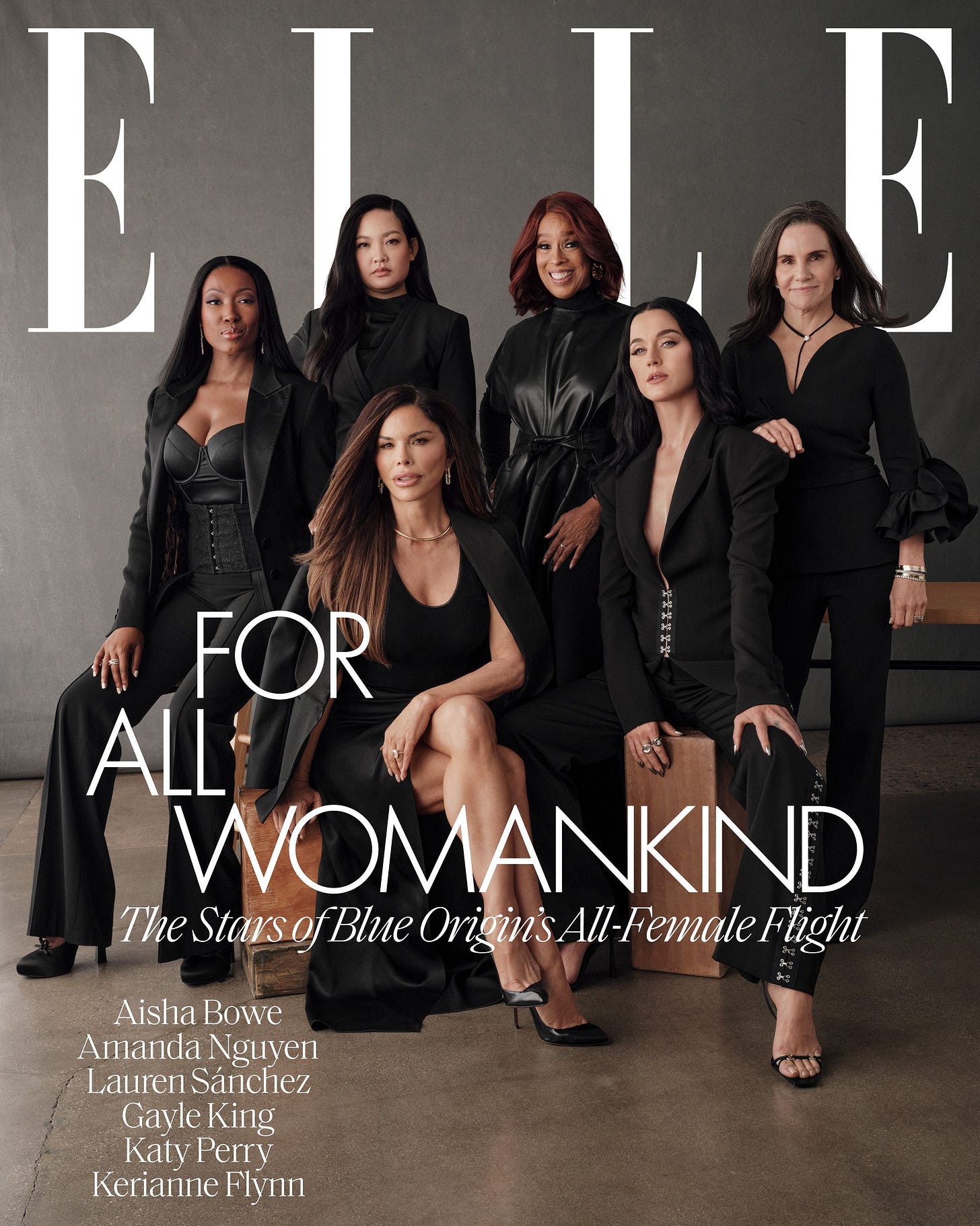To Boldly Go (On an 11-Minute Joyride): Blue Origin’s All-Women Space Spectacle
Launch Party for the End Times!
On the morning of April 14, 2025, a gleaming Blue Origin rocket launched from West Texas, carrying an all-women crew billed as a historic first. Six passengers — a pop superstar, a television anchor, a former NASA engineer, a civil rights activist, a film producer, and the vice-chair of the Bezos Earth Fund — boarded the New Shepard capsule for an 11-minute suborbital journey that had been heralded as a symbolic triumph of empowerment and inclusion.
Headlined by Lauren Sánchez, the former news anchor and helicopter pilot who helped organize the mission and is engaged to Amazon founder Jeff Bezos, the flight was pitched as a milestone for gender equity in space. She was joined by Gayle King of CBS News, global pop star Katy Perry, aerospace engineer Aisha Bowe, Nobel Peace Prize-nominated activist Amanda Nguyen, and filmmaker Kerianne Flynn. The moment was staged with all the hallmarks of significance: coordinated press releases, televised interviews, high-profile endorsements, and a steady drumbeat of celebration around the phrase “first all-female spaceflight.”
But as the capsule parachuted back to Earth just minutes later, one couldn’t help but feel that the final frontier had never felt more like a stage. In the hours since, the public response has been a blend of admiration, confusion, and satire. Was this a giant leap for womankind, or simply a well-branded victory lap for a billionaire’s inner circle?
The Billionaire's Playhouse Disguised as Progress
The Blue Origin mission, dubbed NS-31, was a private flight organized outside the usual structures of scientific research or space exploration. Unlike previous missions governed by national space agencies and decades of astronaut training, this crew was curated — hand-selected by Sánchez to showcase a kind of glossy, aestheticized representation. It was less NASA, more Elle.
Blue Origin has long positioned itself as a pioneer of commercial space travel. But its voyages, which last less than 15 minutes from launch to touchdown, have become symbols of excess. Though the company claims to be making space “more accessible,” seats remain unattainable for all but the ultra-wealthy or well-connected. Prices are not publicly disclosed, but industry insiders estimate the cost per ticket to be in the high six figures.
This most recent flight may have been intended to symbolize inclusion, but it was also a clear continuation of a pattern: using spectacle to obscure inequity. In the 1960s, the Space Race reflected Cold War ambition and national investment in science. In 2025, a suborbital trip lasting the length of a pop song is marketed as progress. That shift matters.
And it’s not just the shift — it’s the swap. We’ve swapped propulsion for performance. Public interest for private influence. Genuine firsts for filtered selfies. NS-31 didn’t take us further into space; it floated us deeper into the curated theater of elite aspiration.
Curated Inclusion or Branded Equality?
There’s no denying that the crew members are accomplished. Aisha Bowe is a respected engineer and entrepreneur. Amanda Nguyen has fought tirelessly for the rights of sexual assault survivors. Gayle King is a broadcasting veteran. And even Katy Perry, while an unconventional astronaut, has used her platform for philanthropic causes (as well as cultural appropriation: read here).But in the wake of the launch, public discourse turned to who gets selected to embody “empowerment” — and who gets left behind.
This question isn’t new. From the earliest days of spaceflight, representation has always been selective. Only about 11% of all astronauts in history have been women. Fewer still are Black, Indigenous, or people of color. An all-female crew does matter. Symbolism matters. But when symbolism is curated by the powerful — and when that curation does not reflect wider systems of access — we have to ask what stories are being told, and for whom.
Was this an act of social progress, or a very expensive promotional event? And if women are now “taking up space,” as the mission hashtag declared, which women? On what terms? And at what altitude?


When Space Gets a Stylist
In the run-up to the flight, media coverage highlighted the crew’s fashion choices, photoshoots, and launch-day glam routines. Sánchez and Perry shared behind-the-scenes footage of their matching flight suits, customized mission patches, and lash-extension strategies for zero gravity. Perry posted on Instagram about feeling “aligned with the universe.”
These elements may seem frivolous — and in some ways they were — but they also speak to how much American spaceflight has shifted in tone. Where astronauts once donned utilitarian jumpsuits and spoke in stoic, clipped tones about scientific goals, this crew laughed about microgravity hairstyles and skincare routines. It’s not that women shouldn’t bring their full selves into traditionally male-dominated spaces. But the emphasis on fashion and glamour framed the mission as a spectacle, not a milestone.
What we were watching wasn’t a moonshot. It was a moodboard. A vibe-lift. And the question isn’t whether these women deserved to go to space — it’s why space has become the latest backdrop for branding exercises.
What It Means to Float Above the Cost of Eggs
In the hours following the launch, conversations turned toward economic inequality, climate disruption, and the state of American infrastructure. Olivia Munn, in a television appearance, questioned the value of such a flight in a time of economic instability. “There are people who can’t even afford eggs,” she said. “It feels like a joyride. A very glamorous one, but a joyride.”
And she wasn’t wrong. America is facing overlapping crises — housing insecurity, water contamination, rising maternal mortality rates, attacks on reproductive rights, climate-fueled disaster. The contrast between a multimillion-dollar space capsule floating above the atmosphere and a nation struggling to care for its most vulnerable is jarring.
The Blue Origin flight was meant to inspire. But inspiration, when untethered from equity, starts to resemble delusion. And sometimes, all that floating feels like avoidance. As if the more polished the image, the less we’re expected to notice the missing pieces.
"Sleep: Deux Femmes Noires"
If Blue Origin’s capsule sold us a version of elevation as escape — sleek, sponsored, floating free of consequence — Mickalene Thomas gives us the real architecture of ascension: a layered, luscious reclamation that doesn’t leave Earth, but redefines who owns it.
In Sleep: Deux Femmes Noires (2012), Thomas restages Gustave Courbet’s Le Sommeil (1866) — a canonical painting of two white women draped on satin sheets — and replaces it with unapologetic Black presence. Her women are radiant, reclining, and fully in control of their gaze. They’re not asleep; they’re awake in the tradition, staring it down.
The surface bursts with rhinestones, collaged landscapes, and boldly outlined limbs that interrupt the Western art canon’s soft-focus on whiteness. The background borrows from David Hockney’s swimming-pool palettes, filtered through 1970s interior aesthetics and Black domestic memory. It’s part glam, part critique — and completely Thomas.
This isn’t about homage. It’s a decolonial fracture. Her Black women aren’t inserted into European art history to be decorative. They dismantle it. They stretch across the canvas in primary yellows and inky blacks, daring the viewer to reconcile their presence with the traditions they destabilize. The bodies don’t belong to the viewer — they belong to themselves, glossy and gorgeous, yes, but also assertive, abstracted, and whole.
The piece doesn’t offer transcendence through escape. It demands reckoning through presence. Where the Blue Origin women were launched for 11 minutes and called “astronauts,” Thomas’s figures have been grounded for centuries and still manage to be more cosmic. They aren’t taking up space. They are space.
As Thomas once said, “I’m not painting just to be seen. I’m painting so that we can be remembered.”
After the Applause: Who’s Still Grounded?
Now that the launch has passed, what has changed? Blue Origin completed its mission. The women floated, cheered, shared their reflections, and returned to social media to bask in the glow. The press moved on.
But beneath the fanfare, the deeper questions remain. Can symbolic gestures replace structural change? Can curated visibility trickle down into real access? And what happens when the stories we tell about progress float too far from the ground?
The spaceflight may have lasted only 11 minutes. But its symbolism will linger. For some, it was a dream realized. For others, it was a distraction. For all of us, it was a reminder: representation without redistribution is a rocket without a destination.
Let’s look up. Let’s be inspired. But let’s not forget to look around — at who is still grounded, and at what it might take for them to rise.










Why does this rocket look like a Penis?